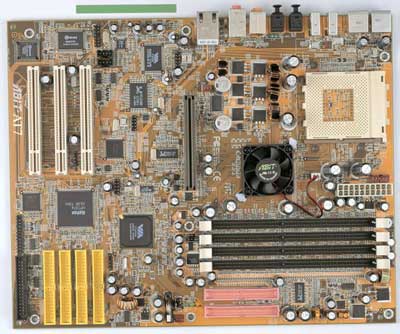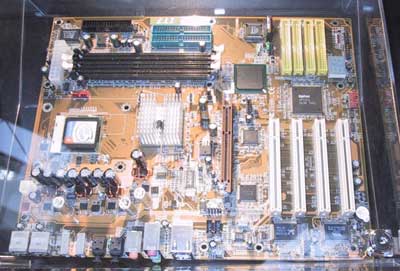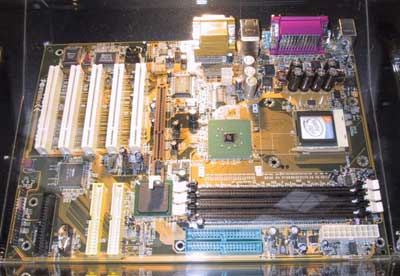CeBIT 2002 Part 2 - CPUs, Cooling, Motherboards, & Video
by Tillmann Steinbrecher on March 20, 2002 1:56 AM EST- Posted in
- Trade Shows
ABIT

ABIT AT7 (picture from ABIT's "press kit" CD-ROM) - Click to Enlarge
This is ABIT's Via KT333 solution for Athlon. The board's layout
and features are quite unusual. The board only has 3 PCI slots, but the large
amount of onboard features compensates for that. This includes Highpoint onboard
IDE RAID, a Realtek Fast Ethernet chip, and an IEEE 1394 (FireWire) interface.
Also, note the four slots for DDR SDRAM. The on-board Highpoint RAID controller provides four Ultra ATA 133 RAID channels in addition to the two ATA 133 channels driven by the KT333 South Bridge. This allows for a total of 12 IDE drives to be attached to the motherboard.
Another interesting detail is the optical SP/DIF digital sound in- and output.
This is a great thing: Lots of copy-protected CDs that can't be ripped using
a CD-ROM drive are showing up on the market these days. With the aid of an audio
CD player with digital output (standard on most players) and an SP/DIF input,
it will still be possible to make perfect digital copies of such CDs - so we
are sure that there will be a lot of interest in motherboards and sound cards
with SP/DIF in. ABIT's idea to integrated these ports on all of its current
motherboards is certainly a step into the right direction.
The SP/DIF output is a nice idea as well - since it allows you to digitally
connect an external high end DAC or DAT/Minidisc recorder in order to do the
D/A conversion. In theory, this would give you much better sound quality than
any sound card can provide. However, most SP/DIF outputs are flawed, since they
only support 48kHz sampling rate. If sound is played at 44.1kHz (the sampling
rate of audio CDs and thus of most MP3s), the sampling rate will be converted
to 48kHz, which degrades quality. Only the sound chips from CMedia do not have
this problem and can do perfect SP/DIF out at 44.1kHz - but unfortunately ABIT
is using the chipset's AC97 audio, and not a CMedia chip.
The AT7 has a few more disadvantages. One is obvious: the lack of legacy serial/parallel
ports (which can be an advantage for some). The other one is the fact that the
AT7 cannot read the internal thermal diode of the Palomino core, and relies
on a not-so-precise NTC which measures temperature below the CPU instead. ABIT's
excuse for this was that "the chipset doesn't support it" - that is very astonishing,
especially considering that ASUS, MSI, and DFI all have KT333 boards that do
support reading the temperature from the Palomino's on-die thermister.
Still, the AT7 looks like a very interesting board, this certainly isn't the
last time you'll read about it on AnandTech.
ABIT plans to ship future board with the four mounting holes for large heatsinks
around the socket. These holes are no longer mandatory in the latest revision
of AMD's specs, and some manufacturers already ship boards without the mounting
holes.
Here's a close-up of the connectors of ABIT's new motherboards. Note the Fire Wire and SP/DIF interfaces, and also note the lack of "legacy" serial and parallel ports.
This is ABIT's Intel 845-based board for P4. It has all the great
features of the AT7 (RAID, Fire Wire, SP/DIF interface), plus a Port 80 diagnostic
display for easy troubleshooting. Also check out the nice passive heatsink on
the chipset - certainly a much better solution than a tiny sink with an unreliable
and often noisy fan on it.
Just like the AT7, this is a legacy-free board.
The BD7II-RAID is a more "classical" board: No Port 80 diagnostic, and only RAID onboard. Legacy ports (serial, parallel) are included.













1 Comments
View All Comments
Dr AB - Monday, May 11, 2020 - link
MSI & ASUS - Hmm looks like we are looking at the very start of an interesting era. And yes, Cooler Master. ;)